Evaluation of the YMCA Victoria Health Promotion Program
VerifiedAdded on 2023/06/04
|9
|3036
|317
Report
AI Summary
This report details a process evaluation plan for the YMCA Victoria health promotion program, specifically focusing on the initiative to reduce sugary foods and beverages in its recreational centers. The evaluation examines the program's goals, which are to improve the health and happiness of the Victorian population by promoting healthy food choices and restricting unhealthy options. The primary objective is the ban on soft drinks. The report includes a literature review highlighting the importance of healthy eating and the role of environment in making healthy choices. A formative evaluation strategy is proposed, incorporating surveys and interviews to gather data on program implementation, changes in customer behavior, and financial implications. The evaluation design employs a logic model to assess the program's short-term and intermediate outcomes, along with data collection methods from YMCA Victoria members. The report outlines the evaluation questions, indicators, and data collection methods, emphasizing the importance of stakeholder involvement for program success. The evaluation seeks to show that for a program to succeed all stakeholders have to be on board. The funders of the program need to be on board by providing the resources necessary including but not limited to money and personnel. They community, who are the primary recipient of the services need to feel part of the program. The legislative authorities play a fundamental role in institutionalizing laws and collaborating with local key players in realizing the set goals.
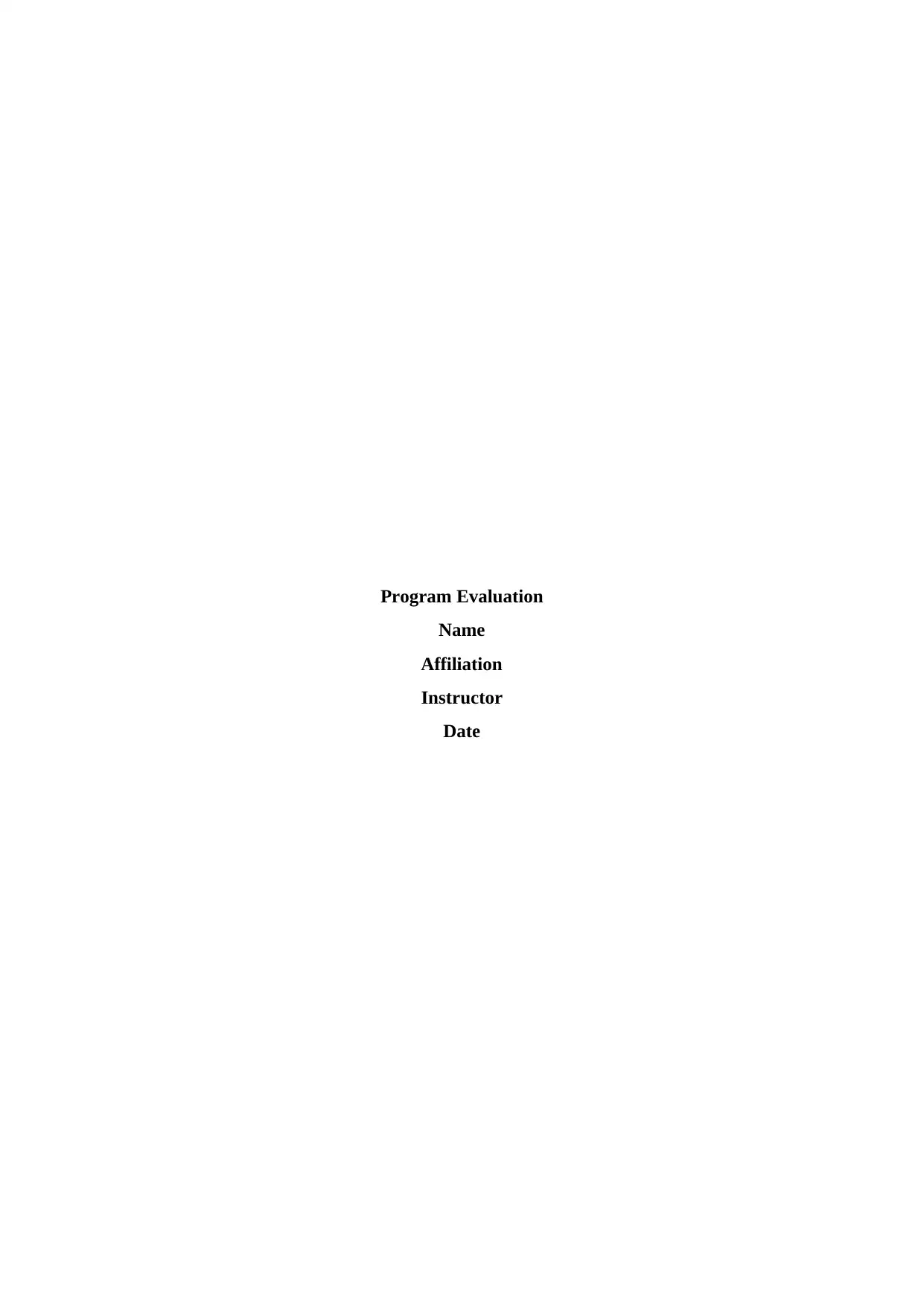
Program Evaluation
Name
Affiliation
Instructor
Date
Name
Affiliation
Instructor
Date
Paraphrase This Document
Need a fresh take? Get an instant paraphrase of this document with our AI Paraphraser
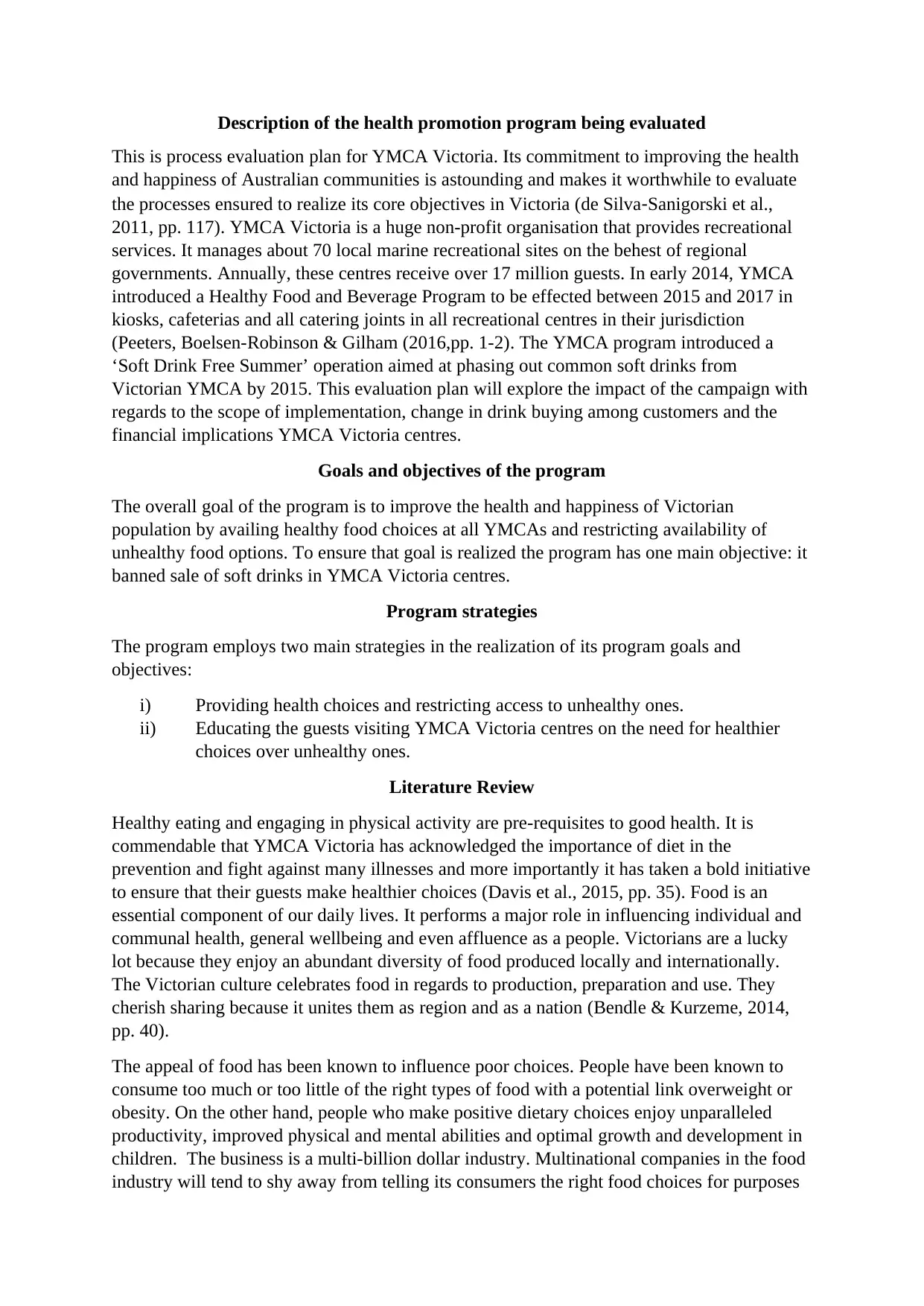
Description of the health promotion program being evaluated
This is process evaluation plan for YMCA Victoria. Its commitment to improving the health
and happiness of Australian communities is astounding and makes it worthwhile to evaluate
the processes ensured to realize its core objectives in Victoria (de Silva‐Sanigorski et al.,
2011, pp. 117). YMCA Victoria is a huge non-profit organisation that provides recreational
services. It manages about 70 local marine recreational sites on the behest of regional
governments. Annually, these centres receive over 17 million guests. In early 2014, YMCA
introduced a Healthy Food and Beverage Program to be effected between 2015 and 2017 in
kiosks, cafeterias and all catering joints in all recreational centres in their jurisdiction
(Peeters, Boelsen-Robinson & Gilham (2016,pp. 1-2). The YMCA program introduced a
‘Soft Drink Free Summer’ operation aimed at phasing out common soft drinks from
Victorian YMCA by 2015. This evaluation plan will explore the impact of the campaign with
regards to the scope of implementation, change in drink buying among customers and the
financial implications YMCA Victoria centres.
Goals and objectives of the program
The overall goal of the program is to improve the health and happiness of Victorian
population by availing healthy food choices at all YMCAs and restricting availability of
unhealthy food options. To ensure that goal is realized the program has one main objective: it
banned sale of soft drinks in YMCA Victoria centres.
Program strategies
The program employs two main strategies in the realization of its program goals and
objectives:
i) Providing health choices and restricting access to unhealthy ones.
ii) Educating the guests visiting YMCA Victoria centres on the need for healthier
choices over unhealthy ones.
Literature Review
Healthy eating and engaging in physical activity are pre-requisites to good health. It is
commendable that YMCA Victoria has acknowledged the importance of diet in the
prevention and fight against many illnesses and more importantly it has taken a bold initiative
to ensure that their guests make healthier choices (Davis et al., 2015, pp. 35). Food is an
essential component of our daily lives. It performs a major role in influencing individual and
communal health, general wellbeing and even affluence as a people. Victorians are a lucky
lot because they enjoy an abundant diversity of food produced locally and internationally.
The Victorian culture celebrates food in regards to production, preparation and use. They
cherish sharing because it unites them as region and as a nation (Bendle & Kurzeme, 2014,
pp. 40).
The appeal of food has been known to influence poor choices. People have been known to
consume too much or too little of the right types of food with a potential link overweight or
obesity. On the other hand, people who make positive dietary choices enjoy unparalleled
productivity, improved physical and mental abilities and optimal growth and development in
children. The business is a multi-billion dollar industry. Multinational companies in the food
industry will tend to shy away from telling its consumers the right food choices for purposes
This is process evaluation plan for YMCA Victoria. Its commitment to improving the health
and happiness of Australian communities is astounding and makes it worthwhile to evaluate
the processes ensured to realize its core objectives in Victoria (de Silva‐Sanigorski et al.,
2011, pp. 117). YMCA Victoria is a huge non-profit organisation that provides recreational
services. It manages about 70 local marine recreational sites on the behest of regional
governments. Annually, these centres receive over 17 million guests. In early 2014, YMCA
introduced a Healthy Food and Beverage Program to be effected between 2015 and 2017 in
kiosks, cafeterias and all catering joints in all recreational centres in their jurisdiction
(Peeters, Boelsen-Robinson & Gilham (2016,pp. 1-2). The YMCA program introduced a
‘Soft Drink Free Summer’ operation aimed at phasing out common soft drinks from
Victorian YMCA by 2015. This evaluation plan will explore the impact of the campaign with
regards to the scope of implementation, change in drink buying among customers and the
financial implications YMCA Victoria centres.
Goals and objectives of the program
The overall goal of the program is to improve the health and happiness of Victorian
population by availing healthy food choices at all YMCAs and restricting availability of
unhealthy food options. To ensure that goal is realized the program has one main objective: it
banned sale of soft drinks in YMCA Victoria centres.
Program strategies
The program employs two main strategies in the realization of its program goals and
objectives:
i) Providing health choices and restricting access to unhealthy ones.
ii) Educating the guests visiting YMCA Victoria centres on the need for healthier
choices over unhealthy ones.
Literature Review
Healthy eating and engaging in physical activity are pre-requisites to good health. It is
commendable that YMCA Victoria has acknowledged the importance of diet in the
prevention and fight against many illnesses and more importantly it has taken a bold initiative
to ensure that their guests make healthier choices (Davis et al., 2015, pp. 35). Food is an
essential component of our daily lives. It performs a major role in influencing individual and
communal health, general wellbeing and even affluence as a people. Victorians are a lucky
lot because they enjoy an abundant diversity of food produced locally and internationally.
The Victorian culture celebrates food in regards to production, preparation and use. They
cherish sharing because it unites them as region and as a nation (Bendle & Kurzeme, 2014,
pp. 40).
The appeal of food has been known to influence poor choices. People have been known to
consume too much or too little of the right types of food with a potential link overweight or
obesity. On the other hand, people who make positive dietary choices enjoy unparalleled
productivity, improved physical and mental abilities and optimal growth and development in
children. The business is a multi-billion dollar industry. Multinational companies in the food
industry will tend to shy away from telling its consumers the right food choices for purposes
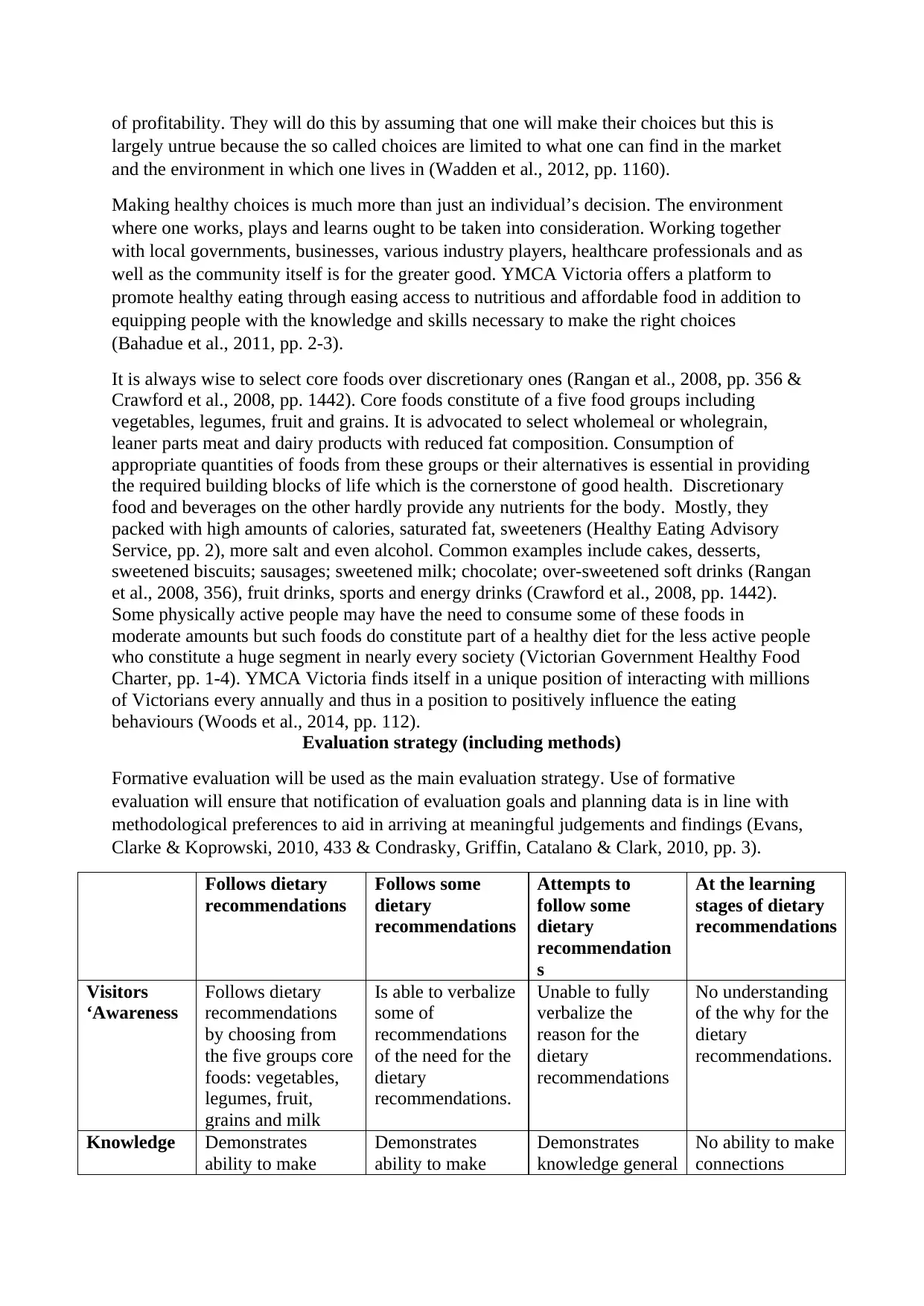
of profitability. They will do this by assuming that one will make their choices but this is
largely untrue because the so called choices are limited to what one can find in the market
and the environment in which one lives in (Wadden et al., 2012, pp. 1160).
Making healthy choices is much more than just an individual’s decision. The environment
where one works, plays and learns ought to be taken into consideration. Working together
with local governments, businesses, various industry players, healthcare professionals and as
well as the community itself is for the greater good. YMCA Victoria offers a platform to
promote healthy eating through easing access to nutritious and affordable food in addition to
equipping people with the knowledge and skills necessary to make the right choices
(Bahadue et al., 2011, pp. 2-3).
It is always wise to select core foods over discretionary ones (Rangan et al., 2008, pp. 356 &
Crawford et al., 2008, pp. 1442). Core foods constitute of a five food groups including
vegetables, legumes, fruit and grains. It is advocated to select wholemeal or wholegrain,
leaner parts meat and dairy products with reduced fat composition. Consumption of
appropriate quantities of foods from these groups or their alternatives is essential in providing
the required building blocks of life which is the cornerstone of good health. Discretionary
food and beverages on the other hardly provide any nutrients for the body. Mostly, they
packed with high amounts of calories, saturated fat, sweeteners (Healthy Eating Advisory
Service, pp. 2), more salt and even alcohol. Common examples include cakes, desserts,
sweetened biscuits; sausages; sweetened milk; chocolate; over-sweetened soft drinks (Rangan
et al., 2008, 356), fruit drinks, sports and energy drinks (Crawford et al., 2008, pp. 1442).
Some physically active people may have the need to consume some of these foods in
moderate amounts but such foods do constitute part of a healthy diet for the less active people
who constitute a huge segment in nearly every society (Victorian Government Healthy Food
Charter, pp. 1-4). YMCA Victoria finds itself in a unique position of interacting with millions
of Victorians every annually and thus in a position to positively influence the eating
behaviours (Woods et al., 2014, pp. 112).
Evaluation strategy (including methods)
Formative evaluation will be used as the main evaluation strategy. Use of formative
evaluation will ensure that notification of evaluation goals and planning data is in line with
methodological preferences to aid in arriving at meaningful judgements and findings (Evans,
Clarke & Koprowski, 2010, 433 & Condrasky, Griffin, Catalano & Clark, 2010, pp. 3).
Follows dietary
recommendations
Follows some
dietary
recommendations
Attempts to
follow some
dietary
recommendation
s
At the learning
stages of dietary
recommendations
Visitors
‘Awareness
Follows dietary
recommendations
by choosing from
the five groups core
foods: vegetables,
legumes, fruit,
grains and milk
Is able to verbalize
some of
recommendations
of the need for the
dietary
recommendations.
Unable to fully
verbalize the
reason for the
dietary
recommendations
No understanding
of the why for the
dietary
recommendations.
Knowledge Demonstrates
ability to make
Demonstrates
ability to make
Demonstrates
knowledge general
No ability to make
connections
largely untrue because the so called choices are limited to what one can find in the market
and the environment in which one lives in (Wadden et al., 2012, pp. 1160).
Making healthy choices is much more than just an individual’s decision. The environment
where one works, plays and learns ought to be taken into consideration. Working together
with local governments, businesses, various industry players, healthcare professionals and as
well as the community itself is for the greater good. YMCA Victoria offers a platform to
promote healthy eating through easing access to nutritious and affordable food in addition to
equipping people with the knowledge and skills necessary to make the right choices
(Bahadue et al., 2011, pp. 2-3).
It is always wise to select core foods over discretionary ones (Rangan et al., 2008, pp. 356 &
Crawford et al., 2008, pp. 1442). Core foods constitute of a five food groups including
vegetables, legumes, fruit and grains. It is advocated to select wholemeal or wholegrain,
leaner parts meat and dairy products with reduced fat composition. Consumption of
appropriate quantities of foods from these groups or their alternatives is essential in providing
the required building blocks of life which is the cornerstone of good health. Discretionary
food and beverages on the other hardly provide any nutrients for the body. Mostly, they
packed with high amounts of calories, saturated fat, sweeteners (Healthy Eating Advisory
Service, pp. 2), more salt and even alcohol. Common examples include cakes, desserts,
sweetened biscuits; sausages; sweetened milk; chocolate; over-sweetened soft drinks (Rangan
et al., 2008, 356), fruit drinks, sports and energy drinks (Crawford et al., 2008, pp. 1442).
Some physically active people may have the need to consume some of these foods in
moderate amounts but such foods do constitute part of a healthy diet for the less active people
who constitute a huge segment in nearly every society (Victorian Government Healthy Food
Charter, pp. 1-4). YMCA Victoria finds itself in a unique position of interacting with millions
of Victorians every annually and thus in a position to positively influence the eating
behaviours (Woods et al., 2014, pp. 112).
Evaluation strategy (including methods)
Formative evaluation will be used as the main evaluation strategy. Use of formative
evaluation will ensure that notification of evaluation goals and planning data is in line with
methodological preferences to aid in arriving at meaningful judgements and findings (Evans,
Clarke & Koprowski, 2010, 433 & Condrasky, Griffin, Catalano & Clark, 2010, pp. 3).
Follows dietary
recommendations
Follows some
dietary
recommendations
Attempts to
follow some
dietary
recommendation
s
At the learning
stages of dietary
recommendations
Visitors
‘Awareness
Follows dietary
recommendations
by choosing from
the five groups core
foods: vegetables,
legumes, fruit,
grains and milk
Is able to verbalize
some of
recommendations
of the need for the
dietary
recommendations.
Unable to fully
verbalize the
reason for the
dietary
recommendations
No understanding
of the why for the
dietary
recommendations.
Knowledge Demonstrates
ability to make
Demonstrates
ability to make
Demonstrates
knowledge general
No ability to make
connections
⊘ This is a preview!⊘
Do you want full access?
Subscribe today to unlock all pages.

Trusted by 1+ million students worldwide
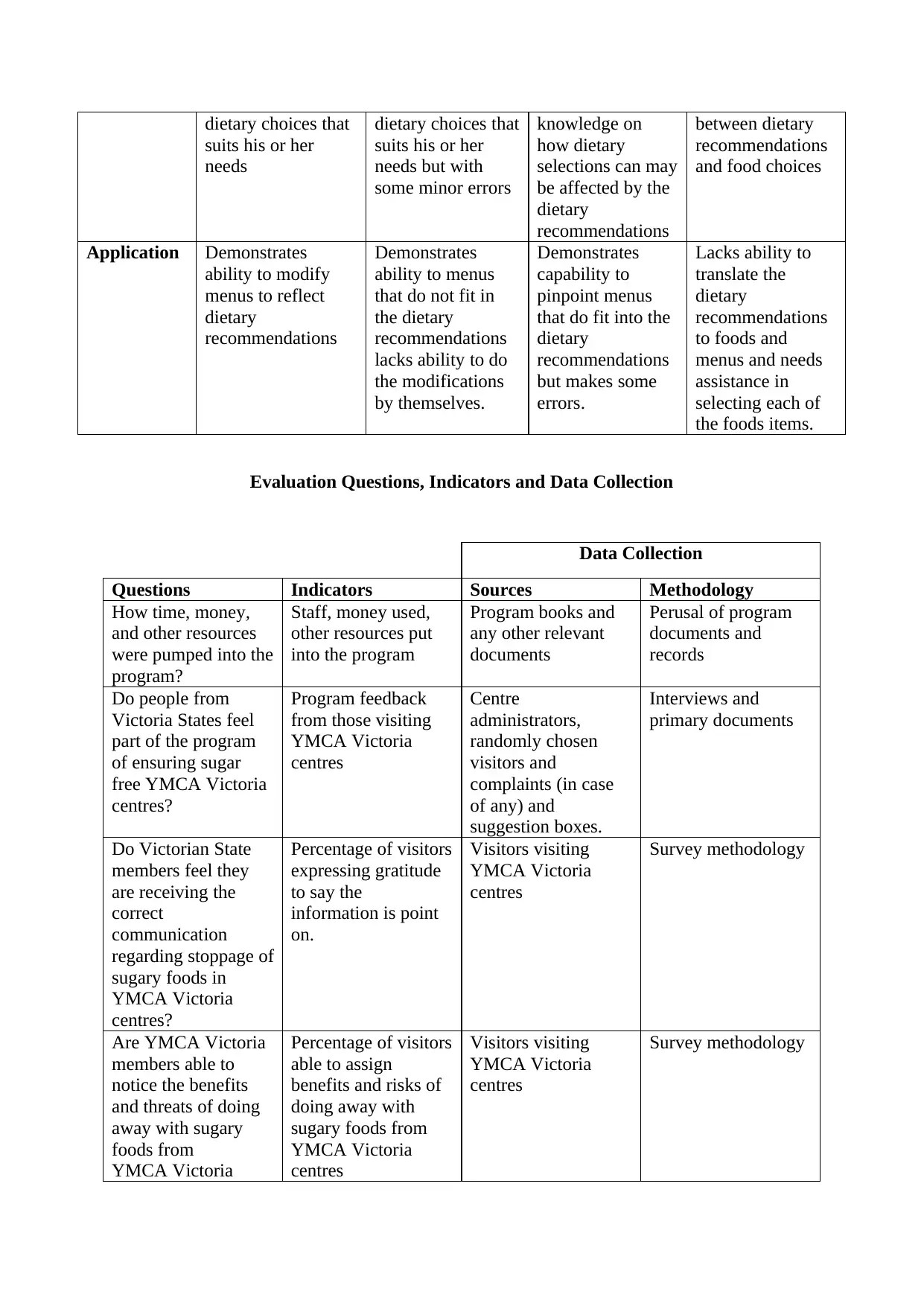
dietary choices that
suits his or her
needs
dietary choices that
suits his or her
needs but with
some minor errors
knowledge on
how dietary
selections can may
be affected by the
dietary
recommendations
between dietary
recommendations
and food choices
Application Demonstrates
ability to modify
menus to reflect
dietary
recommendations
Demonstrates
ability to menus
that do not fit in
the dietary
recommendations
lacks ability to do
the modifications
by themselves.
Demonstrates
capability to
pinpoint menus
that do fit into the
dietary
recommendations
but makes some
errors.
Lacks ability to
translate the
dietary
recommendations
to foods and
menus and needs
assistance in
selecting each of
the foods items.
Evaluation Questions, Indicators and Data Collection
Data Collection
Questions Indicators Sources Methodology
How time, money,
and other resources
were pumped into the
program?
Staff, money used,
other resources put
into the program
Program books and
any other relevant
documents
Perusal of program
documents and
records
Do people from
Victoria States feel
part of the program
of ensuring sugar
free YMCA Victoria
centres?
Program feedback
from those visiting
YMCA Victoria
centres
Centre
administrators,
randomly chosen
visitors and
complaints (in case
of any) and
suggestion boxes.
Interviews and
primary documents
Do Victorian State
members feel they
are receiving the
correct
communication
regarding stoppage of
sugary foods in
YMCA Victoria
centres?
Percentage of visitors
expressing gratitude
to say the
information is point
on.
Visitors visiting
YMCA Victoria
centres
Survey methodology
Are YMCA Victoria
members able to
notice the benefits
and threats of doing
away with sugary
foods from
YMCA Victoria
Percentage of visitors
able to assign
benefits and risks of
doing away with
sugary foods from
YMCA Victoria
centres
Visitors visiting
YMCA Victoria
centres
Survey methodology
suits his or her
needs
dietary choices that
suits his or her
needs but with
some minor errors
knowledge on
how dietary
selections can may
be affected by the
dietary
recommendations
between dietary
recommendations
and food choices
Application Demonstrates
ability to modify
menus to reflect
dietary
recommendations
Demonstrates
ability to menus
that do not fit in
the dietary
recommendations
lacks ability to do
the modifications
by themselves.
Demonstrates
capability to
pinpoint menus
that do fit into the
dietary
recommendations
but makes some
errors.
Lacks ability to
translate the
dietary
recommendations
to foods and
menus and needs
assistance in
selecting each of
the foods items.
Evaluation Questions, Indicators and Data Collection
Data Collection
Questions Indicators Sources Methodology
How time, money,
and other resources
were pumped into the
program?
Staff, money used,
other resources put
into the program
Program books and
any other relevant
documents
Perusal of program
documents and
records
Do people from
Victoria States feel
part of the program
of ensuring sugar
free YMCA Victoria
centres?
Program feedback
from those visiting
YMCA Victoria
centres
Centre
administrators,
randomly chosen
visitors and
complaints (in case
of any) and
suggestion boxes.
Interviews and
primary documents
Do Victorian State
members feel they
are receiving the
correct
communication
regarding stoppage of
sugary foods in
YMCA Victoria
centres?
Percentage of visitors
expressing gratitude
to say the
information is point
on.
Visitors visiting
YMCA Victoria
centres
Survey methodology
Are YMCA Victoria
members able to
notice the benefits
and threats of doing
away with sugary
foods from
YMCA Victoria
Percentage of visitors
able to assign
benefits and risks of
doing away with
sugary foods from
YMCA Victoria
centres
Visitors visiting
YMCA Victoria
centres
Survey methodology
Paraphrase This Document
Need a fresh take? Get an instant paraphrase of this document with our AI Paraphraser
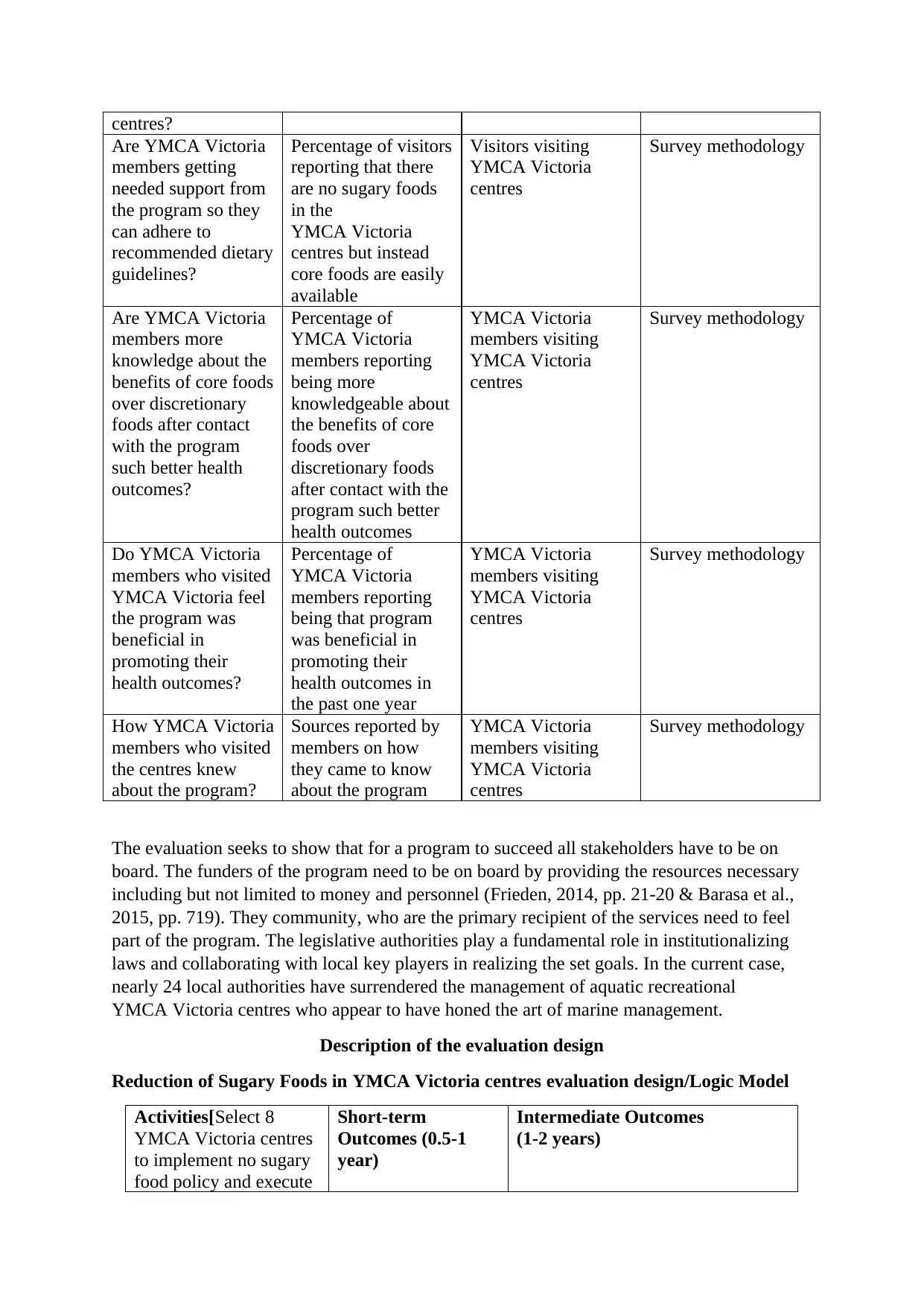
centres?
Are YMCA Victoria
members getting
needed support from
the program so they
can adhere to
recommended dietary
guidelines?
Percentage of visitors
reporting that there
are no sugary foods
in the
YMCA Victoria
centres but instead
core foods are easily
available
Visitors visiting
YMCA Victoria
centres
Survey methodology
Are YMCA Victoria
members more
knowledge about the
benefits of core foods
over discretionary
foods after contact
with the program
such better health
outcomes?
Percentage of
YMCA Victoria
members reporting
being more
knowledgeable about
the benefits of core
foods over
discretionary foods
after contact with the
program such better
health outcomes
YMCA Victoria
members visiting
YMCA Victoria
centres
Survey methodology
Do YMCA Victoria
members who visited
YMCA Victoria feel
the program was
beneficial in
promoting their
health outcomes?
Percentage of
YMCA Victoria
members reporting
being that program
was beneficial in
promoting their
health outcomes in
the past one year
YMCA Victoria
members visiting
YMCA Victoria
centres
Survey methodology
How YMCA Victoria
members who visited
the centres knew
about the program?
Sources reported by
members on how
they came to know
about the program
YMCA Victoria
members visiting
YMCA Victoria
centres
Survey methodology
The evaluation seeks to show that for a program to succeed all stakeholders have to be on
board. The funders of the program need to be on board by providing the resources necessary
including but not limited to money and personnel (Frieden, 2014, pp. 21-20 & Barasa et al.,
2015, pp. 719). They community, who are the primary recipient of the services need to feel
part of the program. The legislative authorities play a fundamental role in institutionalizing
laws and collaborating with local key players in realizing the set goals. In the current case,
nearly 24 local authorities have surrendered the management of aquatic recreational
YMCA Victoria centres who appear to have honed the art of marine management.
Description of the evaluation design
Reduction of Sugary Foods in YMCA Victoria centres evaluation design/Logic Model
Activities[Select 8
YMCA Victoria centres
to implement no sugary
food policy and execute
Short-term
Outcomes (0.5-1
year)
Intermediate Outcomes
(1-2 years)
Are YMCA Victoria
members getting
needed support from
the program so they
can adhere to
recommended dietary
guidelines?
Percentage of visitors
reporting that there
are no sugary foods
in the
YMCA Victoria
centres but instead
core foods are easily
available
Visitors visiting
YMCA Victoria
centres
Survey methodology
Are YMCA Victoria
members more
knowledge about the
benefits of core foods
over discretionary
foods after contact
with the program
such better health
outcomes?
Percentage of
YMCA Victoria
members reporting
being more
knowledgeable about
the benefits of core
foods over
discretionary foods
after contact with the
program such better
health outcomes
YMCA Victoria
members visiting
YMCA Victoria
centres
Survey methodology
Do YMCA Victoria
members who visited
YMCA Victoria feel
the program was
beneficial in
promoting their
health outcomes?
Percentage of
YMCA Victoria
members reporting
being that program
was beneficial in
promoting their
health outcomes in
the past one year
YMCA Victoria
members visiting
YMCA Victoria
centres
Survey methodology
How YMCA Victoria
members who visited
the centres knew
about the program?
Sources reported by
members on how
they came to know
about the program
YMCA Victoria
members visiting
YMCA Victoria
centres
Survey methodology
The evaluation seeks to show that for a program to succeed all stakeholders have to be on
board. The funders of the program need to be on board by providing the resources necessary
including but not limited to money and personnel (Frieden, 2014, pp. 21-20 & Barasa et al.,
2015, pp. 719). They community, who are the primary recipient of the services need to feel
part of the program. The legislative authorities play a fundamental role in institutionalizing
laws and collaborating with local key players in realizing the set goals. In the current case,
nearly 24 local authorities have surrendered the management of aquatic recreational
YMCA Victoria centres who appear to have honed the art of marine management.
Description of the evaluation design
Reduction of Sugary Foods in YMCA Victoria centres evaluation design/Logic Model
Activities[Select 8
YMCA Victoria centres
to implement no sugary
food policy and execute
Short-term
Outcomes (0.5-1
year)
Intermediate Outcomes
(1-2 years)
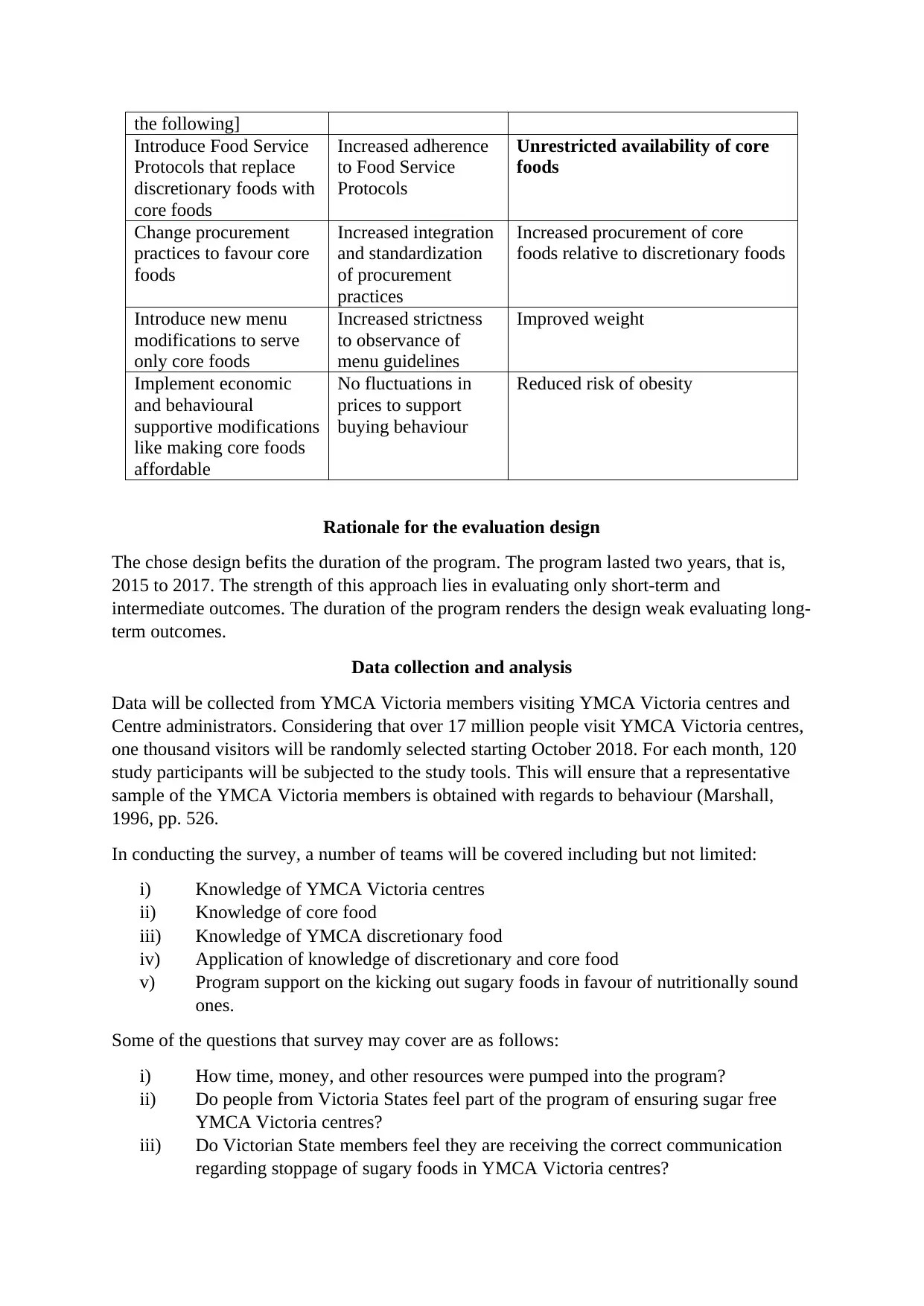
the following]
Introduce Food Service
Protocols that replace
discretionary foods with
core foods
Increased adherence
to Food Service
Protocols
Unrestricted availability of core
foods
Change procurement
practices to favour core
foods
Increased integration
and standardization
of procurement
practices
Increased procurement of core
foods relative to discretionary foods
Introduce new menu
modifications to serve
only core foods
Increased strictness
to observance of
menu guidelines
Improved weight
Implement economic
and behavioural
supportive modifications
like making core foods
affordable
No fluctuations in
prices to support
buying behaviour
Reduced risk of obesity
Rationale for the evaluation design
The chose design befits the duration of the program. The program lasted two years, that is,
2015 to 2017. The strength of this approach lies in evaluating only short-term and
intermediate outcomes. The duration of the program renders the design weak evaluating long-
term outcomes.
Data collection and analysis
Data will be collected from YMCA Victoria members visiting YMCA Victoria centres and
Centre administrators. Considering that over 17 million people visit YMCA Victoria centres,
one thousand visitors will be randomly selected starting October 2018. For each month, 120
study participants will be subjected to the study tools. This will ensure that a representative
sample of the YMCA Victoria members is obtained with regards to behaviour (Marshall,
1996, pp. 526.
In conducting the survey, a number of teams will be covered including but not limited:
i) Knowledge of YMCA Victoria centres
ii) Knowledge of core food
iii) Knowledge of YMCA discretionary food
iv) Application of knowledge of discretionary and core food
v) Program support on the kicking out sugary foods in favour of nutritionally sound
ones.
Some of the questions that survey may cover are as follows:
i) How time, money, and other resources were pumped into the program?
ii) Do people from Victoria States feel part of the program of ensuring sugar free
YMCA Victoria centres?
iii) Do Victorian State members feel they are receiving the correct communication
regarding stoppage of sugary foods in YMCA Victoria centres?
Introduce Food Service
Protocols that replace
discretionary foods with
core foods
Increased adherence
to Food Service
Protocols
Unrestricted availability of core
foods
Change procurement
practices to favour core
foods
Increased integration
and standardization
of procurement
practices
Increased procurement of core
foods relative to discretionary foods
Introduce new menu
modifications to serve
only core foods
Increased strictness
to observance of
menu guidelines
Improved weight
Implement economic
and behavioural
supportive modifications
like making core foods
affordable
No fluctuations in
prices to support
buying behaviour
Reduced risk of obesity
Rationale for the evaluation design
The chose design befits the duration of the program. The program lasted two years, that is,
2015 to 2017. The strength of this approach lies in evaluating only short-term and
intermediate outcomes. The duration of the program renders the design weak evaluating long-
term outcomes.
Data collection and analysis
Data will be collected from YMCA Victoria members visiting YMCA Victoria centres and
Centre administrators. Considering that over 17 million people visit YMCA Victoria centres,
one thousand visitors will be randomly selected starting October 2018. For each month, 120
study participants will be subjected to the study tools. This will ensure that a representative
sample of the YMCA Victoria members is obtained with regards to behaviour (Marshall,
1996, pp. 526.
In conducting the survey, a number of teams will be covered including but not limited:
i) Knowledge of YMCA Victoria centres
ii) Knowledge of core food
iii) Knowledge of YMCA discretionary food
iv) Application of knowledge of discretionary and core food
v) Program support on the kicking out sugary foods in favour of nutritionally sound
ones.
Some of the questions that survey may cover are as follows:
i) How time, money, and other resources were pumped into the program?
ii) Do people from Victoria States feel part of the program of ensuring sugar free
YMCA Victoria centres?
iii) Do Victorian State members feel they are receiving the correct communication
regarding stoppage of sugary foods in YMCA Victoria centres?
⊘ This is a preview!⊘
Do you want full access?
Subscribe today to unlock all pages.

Trusted by 1+ million students worldwide
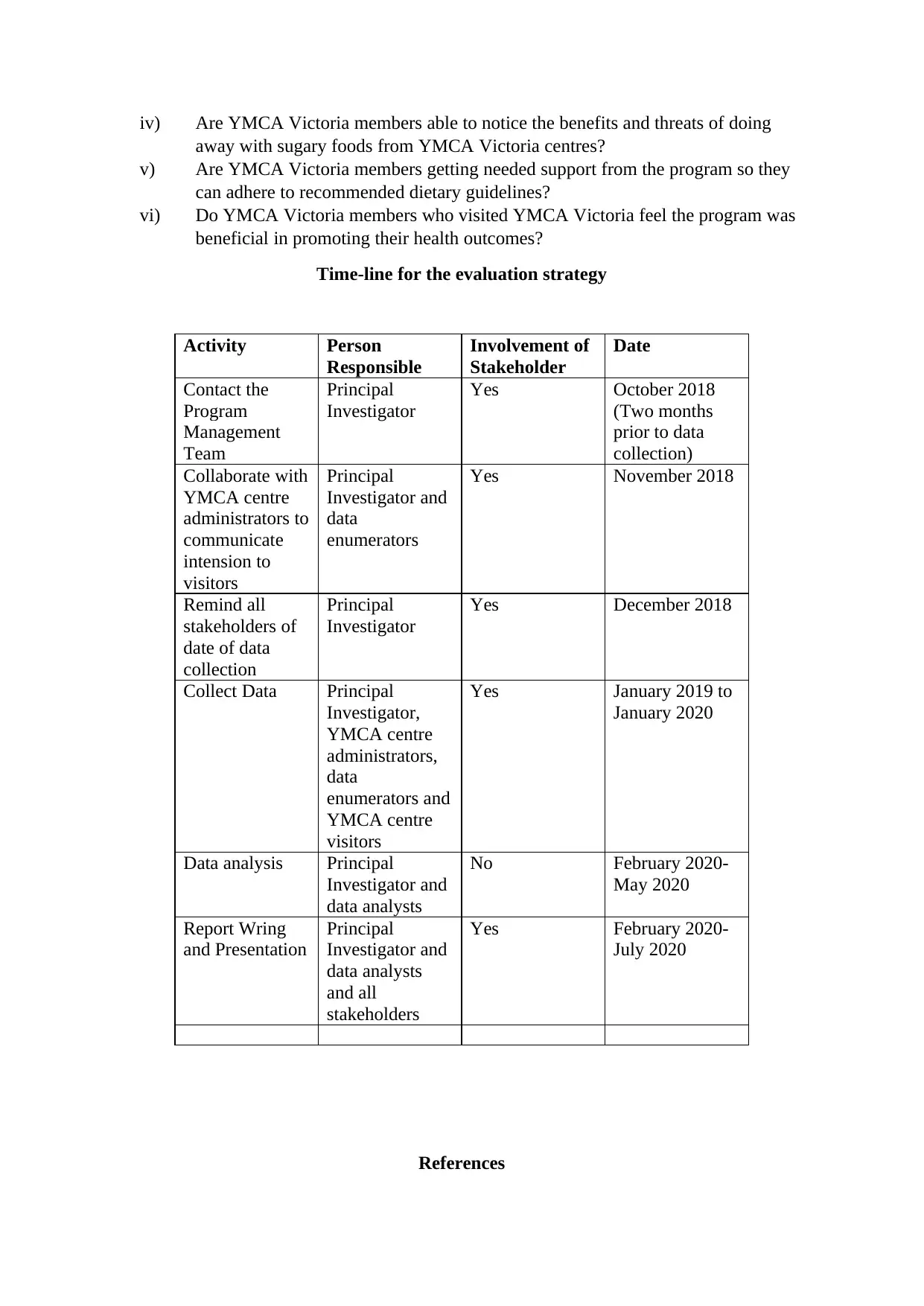
iv) Are YMCA Victoria members able to notice the benefits and threats of doing
away with sugary foods from YMCA Victoria centres?
v) Are YMCA Victoria members getting needed support from the program so they
can adhere to recommended dietary guidelines?
vi) Do YMCA Victoria members who visited YMCA Victoria feel the program was
beneficial in promoting their health outcomes?
Time-line for the evaluation strategy
Activity Person
Responsible
Involvement of
Stakeholder
Date
Contact the
Program
Management
Team
Principal
Investigator
Yes October 2018
(Two months
prior to data
collection)
Collaborate with
YMCA centre
administrators to
communicate
intension to
visitors
Principal
Investigator and
data
enumerators
Yes November 2018
Remind all
stakeholders of
date of data
collection
Principal
Investigator
Yes December 2018
Collect Data Principal
Investigator,
YMCA centre
administrators,
data
enumerators and
YMCA centre
visitors
Yes January 2019 to
January 2020
Data analysis Principal
Investigator and
data analysts
No February 2020-
May 2020
Report Wring
and Presentation
Principal
Investigator and
data analysts
and all
stakeholders
Yes February 2020-
July 2020
References
away with sugary foods from YMCA Victoria centres?
v) Are YMCA Victoria members getting needed support from the program so they
can adhere to recommended dietary guidelines?
vi) Do YMCA Victoria members who visited YMCA Victoria feel the program was
beneficial in promoting their health outcomes?
Time-line for the evaluation strategy
Activity Person
Responsible
Involvement of
Stakeholder
Date
Contact the
Program
Management
Team
Principal
Investigator
Yes October 2018
(Two months
prior to data
collection)
Collaborate with
YMCA centre
administrators to
communicate
intension to
visitors
Principal
Investigator and
data
enumerators
Yes November 2018
Remind all
stakeholders of
date of data
collection
Principal
Investigator
Yes December 2018
Collect Data Principal
Investigator,
YMCA centre
administrators,
data
enumerators and
YMCA centre
visitors
Yes January 2019 to
January 2020
Data analysis Principal
Investigator and
data analysts
No February 2020-
May 2020
Report Wring
and Presentation
Principal
Investigator and
data analysts
and all
stakeholders
Yes February 2020-
July 2020
References
Paraphrase This Document
Need a fresh take? Get an instant paraphrase of this document with our AI Paraphraser
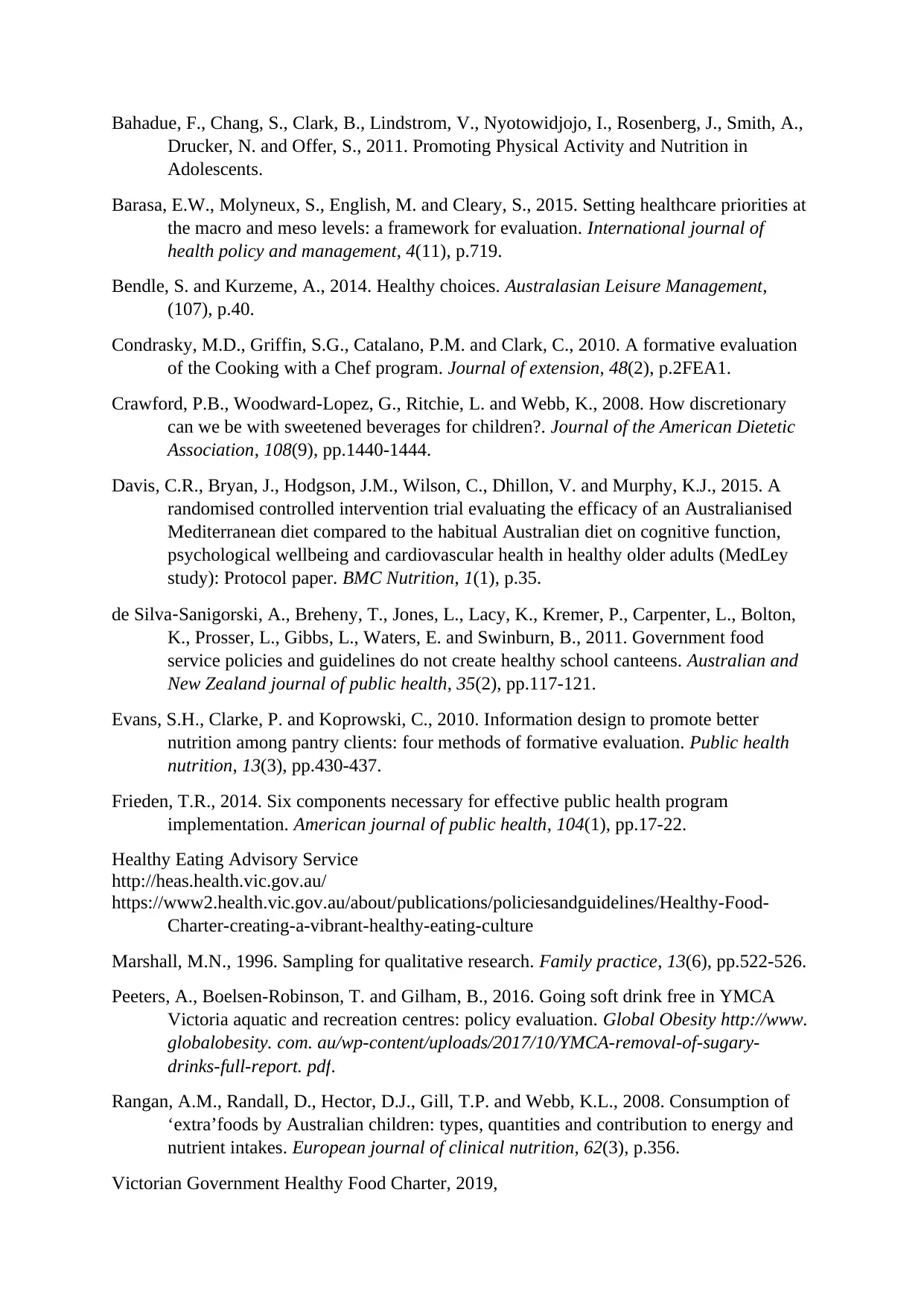
Bahadue, F., Chang, S., Clark, B., Lindstrom, V., Nyotowidjojo, I., Rosenberg, J., Smith, A.,
Drucker, N. and Offer, S., 2011. Promoting Physical Activity and Nutrition in
Adolescents.
Barasa, E.W., Molyneux, S., English, M. and Cleary, S., 2015. Setting healthcare priorities at
the macro and meso levels: a framework for evaluation. International journal of
health policy and management, 4(11), p.719.
Bendle, S. and Kurzeme, A., 2014. Healthy choices. Australasian Leisure Management,
(107), p.40.
Condrasky, M.D., Griffin, S.G., Catalano, P.M. and Clark, C., 2010. A formative evaluation
of the Cooking with a Chef program. Journal of extension, 48(2), p.2FEA1.
Crawford, P.B., Woodward-Lopez, G., Ritchie, L. and Webb, K., 2008. How discretionary
can we be with sweetened beverages for children?. Journal of the American Dietetic
Association, 108(9), pp.1440-1444.
Davis, C.R., Bryan, J., Hodgson, J.M., Wilson, C., Dhillon, V. and Murphy, K.J., 2015. A
randomised controlled intervention trial evaluating the efficacy of an Australianised
Mediterranean diet compared to the habitual Australian diet on cognitive function,
psychological wellbeing and cardiovascular health in healthy older adults (MedLey
study): Protocol paper. BMC Nutrition, 1(1), p.35.
de Silva‐Sanigorski, A., Breheny, T., Jones, L., Lacy, K., Kremer, P., Carpenter, L., Bolton,
K., Prosser, L., Gibbs, L., Waters, E. and Swinburn, B., 2011. Government food
service policies and guidelines do not create healthy school canteens. Australian and
New Zealand journal of public health, 35(2), pp.117-121.
Evans, S.H., Clarke, P. and Koprowski, C., 2010. Information design to promote better
nutrition among pantry clients: four methods of formative evaluation. Public health
nutrition, 13(3), pp.430-437.
Frieden, T.R., 2014. Six components necessary for effective public health program
implementation. American journal of public health, 104(1), pp.17-22.
Healthy Eating Advisory Service
http://heas.health.vic.gov.au/
https://www2.health.vic.gov.au/about/publications/policiesandguidelines/Healthy-Food-
Charter-creating-a-vibrant-healthy-eating-culture
Marshall, M.N., 1996. Sampling for qualitative research. Family practice, 13(6), pp.522-526.
Peeters, A., Boelsen-Robinson, T. and Gilham, B., 2016. Going soft drink free in YMCA
Victoria aquatic and recreation centres: policy evaluation. Global Obesity http://www.
globalobesity. com. au/wp-content/uploads/2017/10/YMCA-removal-of-sugary-
drinks-full-report. pdf.
Rangan, A.M., Randall, D., Hector, D.J., Gill, T.P. and Webb, K.L., 2008. Consumption of
‘extra’foods by Australian children: types, quantities and contribution to energy and
nutrient intakes. European journal of clinical nutrition, 62(3), p.356.
Victorian Government Healthy Food Charter, 2019,
Drucker, N. and Offer, S., 2011. Promoting Physical Activity and Nutrition in
Adolescents.
Barasa, E.W., Molyneux, S., English, M. and Cleary, S., 2015. Setting healthcare priorities at
the macro and meso levels: a framework for evaluation. International journal of
health policy and management, 4(11), p.719.
Bendle, S. and Kurzeme, A., 2014. Healthy choices. Australasian Leisure Management,
(107), p.40.
Condrasky, M.D., Griffin, S.G., Catalano, P.M. and Clark, C., 2010. A formative evaluation
of the Cooking with a Chef program. Journal of extension, 48(2), p.2FEA1.
Crawford, P.B., Woodward-Lopez, G., Ritchie, L. and Webb, K., 2008. How discretionary
can we be with sweetened beverages for children?. Journal of the American Dietetic
Association, 108(9), pp.1440-1444.
Davis, C.R., Bryan, J., Hodgson, J.M., Wilson, C., Dhillon, V. and Murphy, K.J., 2015. A
randomised controlled intervention trial evaluating the efficacy of an Australianised
Mediterranean diet compared to the habitual Australian diet on cognitive function,
psychological wellbeing and cardiovascular health in healthy older adults (MedLey
study): Protocol paper. BMC Nutrition, 1(1), p.35.
de Silva‐Sanigorski, A., Breheny, T., Jones, L., Lacy, K., Kremer, P., Carpenter, L., Bolton,
K., Prosser, L., Gibbs, L., Waters, E. and Swinburn, B., 2011. Government food
service policies and guidelines do not create healthy school canteens. Australian and
New Zealand journal of public health, 35(2), pp.117-121.
Evans, S.H., Clarke, P. and Koprowski, C., 2010. Information design to promote better
nutrition among pantry clients: four methods of formative evaluation. Public health
nutrition, 13(3), pp.430-437.
Frieden, T.R., 2014. Six components necessary for effective public health program
implementation. American journal of public health, 104(1), pp.17-22.
Healthy Eating Advisory Service
http://heas.health.vic.gov.au/
https://www2.health.vic.gov.au/about/publications/policiesandguidelines/Healthy-Food-
Charter-creating-a-vibrant-healthy-eating-culture
Marshall, M.N., 1996. Sampling for qualitative research. Family practice, 13(6), pp.522-526.
Peeters, A., Boelsen-Robinson, T. and Gilham, B., 2016. Going soft drink free in YMCA
Victoria aquatic and recreation centres: policy evaluation. Global Obesity http://www.
globalobesity. com. au/wp-content/uploads/2017/10/YMCA-removal-of-sugary-
drinks-full-report. pdf.
Rangan, A.M., Randall, D., Hector, D.J., Gill, T.P. and Webb, K.L., 2008. Consumption of
‘extra’foods by Australian children: types, quantities and contribution to energy and
nutrient intakes. European journal of clinical nutrition, 62(3), p.356.
Victorian Government Healthy Food Charter, 2019,

Wadden, T.A., Webb, V.L., Moran, C.H. and Bailer, B.A., 2012. Lifestyle modification for
obesity: new developments in diet, physical activity, and behavior
therapy. Circulation, 125(9), pp.1157-1170.
Woods, J., Bressan, A., Langelaan, C., Mallon, A. and Palermo, C., 2014. Australian school
canteens: menu guideline adherence or avoidance?. Health Promotion Journal of
Australia, 25(2), pp.110-115.
obesity: new developments in diet, physical activity, and behavior
therapy. Circulation, 125(9), pp.1157-1170.
Woods, J., Bressan, A., Langelaan, C., Mallon, A. and Palermo, C., 2014. Australian school
canteens: menu guideline adherence or avoidance?. Health Promotion Journal of
Australia, 25(2), pp.110-115.
⊘ This is a preview!⊘
Do you want full access?
Subscribe today to unlock all pages.

Trusted by 1+ million students worldwide
1 out of 9
Your All-in-One AI-Powered Toolkit for Academic Success.
+13062052269
info@desklib.com
Available 24*7 on WhatsApp / Email
![[object Object]](/_next/static/media/star-bottom.7253800d.svg)
Unlock your academic potential
Copyright © 2020–2025 A2Z Services. All Rights Reserved. Developed and managed by ZUCOL.